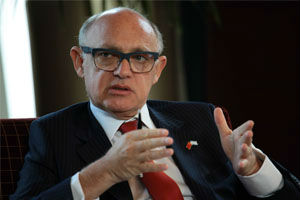UN launches info superhighway map in Asia-Pacific
Updated: 2013-11-19 14:58
(Xinhua)
|
|||||||||||
UNITED NATIONS - The United Nations launched an interactive map of the information superhighway on Monday to help bridge the digital divide in the Asia-Pacific region.
The digital gap in the region, also considered as the inequality of income, education and knowledge, has been widened as a result of uneven technological development, said UN officials.
"Rising inequality - both income and non-income - pose one of the greatest challenges in Asia-Pacific, separating those with education and knowledge from those without," said Noeleen Heyzer, executive secretary of the UN Economic and Social Commission for Asia and the Pacific (ESCAP).
The map, released by ESCAP together with UN International Telecommunication Union (ITU), marks location of missing links in the region, aiming to bring affordable information and communication technology (ICT) and broadband connectivity to all, UN officials said.
UN Secretary-General Ban Ki-moon said in his video message for the launch event that such an effort can help bridge the gap between high-income countries and least developed countries, especially landlocked and small island states in the region.
"It is important that we make the best use of technology to empower people with the information, knowledge and means to improve their lives," he noted.
The map will also provide network planners, policy-makers and regulators from developing countries with a "powerful tool" to assess market opportunities, said ITU Secretary-General Hamadoun Toure.
UN statistics show that the region has the world's highest penetration rate for fixed broadband of 37.56 percent in South Korea and also the lowest rate of 0.01 percent in Myanmar.
"We have seen significant progress in the area of broadband connectivity with the landing of submarine cables in many countries, along with the expansion of national and cross-border fibre backbone networks, as well as mobile and wireless services," Toure said.
Also on Monday, the UN reported that unacceptably high trade costs undermine benefits for least developed and landlocked developing countries though the region outperforms the rest of the world in economic progress with highest growth rates for exports and imports at 5.2 percent and 5.9 percent respectively.
In most cases, it still costs more for Asian subregions to trade with each other than to trade with developed economies outside the region, according to the Asia-Pacific Trade and Investment Report 2013 "Turning the Tide: Towards Inclusive Trade and Investment."
Participants of the launch event also discussed the Asian Highway project which aims to improve highway systems in Asia, highlighting the use of fibre-optic cables in the project to save costs.
Related Stories
UN chief calls for healthy lifestyle to cut incidence of diabetes 2013-11-15 10:38
Philippines typhoon death toll at 4,460: UN 2013-11-15 08:03
Chinese Food Festival kicks off at UN headquarters 2013-11-14 09:57
Afghan opium cultivation at record high: UN 2013-11-14 07:30
Chinese police are on UN mission 2013-11-13 17:39
Today's Top News
China mulls roadmap to tackle climate change
China's FDI edges up 1.2% in Oct
Stocks warm to reform plan
Nation braces for more babies
Polluters still flouting law: inspection
Property prices rise in October
China shares have biggest daily gain in 2 months
Xi meets former US president Clinton
Hot Topics
Lunar probe , China growth forecasts, Emission rules get tougher, China seen through 'colored lens', International board,
Editor's Picks

|

|

|

|

|

|





